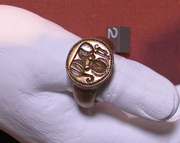 |
 |
 |
 |
 |
 |
 |
|
Fountains Abbey: History
Fountains Abbey: Buildings
|
Sources (2/2) Unfortunately the surrender deed that the community signed on 26 November 1539, and which ended monastic life at Fountains, has not survived. However, other sixteenth-century documents, pre- and post-dating the Dissolution of the abbey, reveal much about monastic life at Fountains at the close of the Middle Ages. These include a lease book, compiled during the abbacies of William Thirsk and Marmaduke Huby, the last two abbots of Fountains. The community had apparently retained much of its land in hand until shortly before the Dissolution, and the lease book reveals details about the duties of tenants and keepers.(5) An inventory taken at the time of the Dissolution lists the weight and value of gold and silver plate belonging to the abbey. It mentions a gold cross, set with stones, wherein lay part of Christ’s cross, weighing fourteen ounces and valued at £30 2s; an image of St James weighed over sixty ounces.(6) A list of pensions awarded to the monks upon their surrender of the abbey has also survived.(7)
Many visual remains of monastic life at Fountains survive to complement these written documents. These include a wide-range of artefacts recovered during excavation of the site, such as wax seals, taps, a sickle head, rings, meat bones, pieces of sculpture, the tombs of former abbots and patrons, and even graffiti. Not least of all, the magnificent ruins of Fountains are a fine tribute and testimony to monastic life at the abbey during the Middle Ages, and can shed considerable light on the history, life and organisation of the community. |
